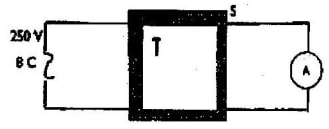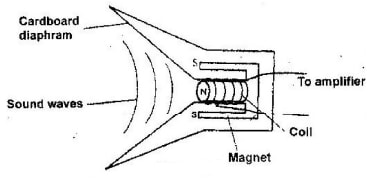Questions
-
- The free ends of a coil are connected to a galvanometer. When the north pole of a magnet is moved towards the coil, the pointer deflects towards the coil, the pointer deflects towards the right as shown. State with reason the behaviour of the pointer in the following cases.

- The north pole of the magnet is held stationary near p.
- The south pole of the magnet is made to approach the coil from Q.
- Two coils T and S are wound on a soft iron core as shown. T has 1000 turns while S has 600 turns and resistance of 100Ω

Calculate the maximum current measured by the ammeter.
- The free ends of a coil are connected to a galvanometer. When the north pole of a magnet is moved towards the coil, the pointer deflects towards the coil, the pointer deflects towards the right as shown. State with reason the behaviour of the pointer in the following cases.
- Calculate the peak value of an alternating current which has a root mean square value of 3.0A.
- A large sub station transformer is used to step down voltage from 11,000V to 450V.
- Determine the ratio of the turns in the primary to secondary coils.
- How is the efficiency of this transformer ensured?
- State one function of the core in a transformer.
- A generator produces a peak voltage of 220v. What is the root mean square value of this voltage?.
- Name any two ways by which a transformer loses energy.
- The figure below; Represents a transformer connected to an ac source and a resistor R.

Compare the magnitudes of the:- Voltages Vp and Vs
- Currents Ip and Is
-
- State the laws of electromagnetic induction.
-
- A researcher studying the behaviour of step up transformer made the following observation. ‘More joules per coulomb and fewer coulombs per second at the output than at the input terminals’. Explain why the observation does not imply a violation of the principle of conservation of energy.
- A transformer of 480 turns in the primary coil used to connect a 9-volt a.c. electric device to a 240V a.c. mains power supply. Calculate the number of turns in the secondary coil
- What causes electromagnetic damping in a moving coil galvanometer?
- State how Eddy Currents are reduced in a transformer.
- A transformer in a welding machine supplies 6 volts from a 240V mains supply. If the current used in the welding is 30A. Determine the current in the mains.
- A hair drier is rated 2500W, 240v. Determine its resistance. (3mks)
-
- State Lenz's law of electromagnetic induction. (1mk)
- The figure below shows a simple microphone in which sound waves from the person talking cause the cardboard diaphragm to vibrate.

- Explain how a varying current is induced in the cell when the diaphragm vibrates. (3mks)
- State two ways in which the induced current (i) above can be increased. (2mks)
- A transformer with 1200 turns in the primary circuit and 120 turns in the secondary circuit; it produces heat at the rate of 600w. Assuming 100% efficiency, determine the:
- Voltage in the secondary circuit. (2mks)
- Current in the secomdary circuit. (2mks)
- The current in the primary circuit. (1mark)
- An ac flows in a resistor of 100Ω. If the peak value of the voltage across the resistor is 60V. Calculate.
- The rms. Voltage
- The rms. Current
- A student designed a transformer to supply a current of 10A at a potential difference of 60V to a motor from an A.C mains supply of 240V. If the efficiency of the transformer is 80%, determine the;
- Power supplied to the transformer
- Current in the primary coil.
- An immersion heater rated 300W is used continuously for 45 minutes per day. Calculate the cost per week at 60cts per unit.
- A radio transmitter directs pulses of waves towards a satellite from which reflections are received 10 millisecond after transmission. Determine the distance of the satellite from the radio transmitter. (Speed of radio waves= 3 x 108ms-1)
- An electric bulb with a filament resistance 300Ω is connected to a 2v main supply, determine the energy dissipated in 2 minutes.
- A 50w bulb is used continuously for 36 hours. Determine the cost of energy consumed at a cost of Kshs. 2 per unit.
- The diagram in the figure below shows an arrangement that may be used to investigate how electromagnetic force varies with current. Explain how the arrangement may be used for this investigation.

Answers
-
-
- No deflection: no change of magnetic flux cutting across the coil.
- The deflection is in the same direction. A south pole is created to oppose the incoming south. It is the same as north approaching the opposite end.
- Assuming 100% efficiency.
Ns = Ip but Is = V = 250 = 2.5A
Np Is R 100
Is = 1000 x 2.5
600
= 4.2A
-
- Imax = √2 x 3
= 4.24 A -
- Np = 1000 = 24.4
Ns 450 - Cooling it, core made of material of low retentivity and it is laminated, proper winding to reduce magnetic flux loss.
- Concentrate and reduce loss of magnetic flux.
- Np = 1000 = 24.4
- Vr.m.s. = 220/√2
= 155.6V - - Hysteresis loses.
- Copper loses.
- Iron loses. -
- Ns = Vs = 5
Np Vp 6 - Is = 6
Ip 5
- Ns = Vs = 5
-
-
- Lenz’s law – The induced current flow is a direction such as to oppose the change producing it.
- Faraday’s law – Whenever there is change in magnetic flux linked to a coil, a current/e.m.f. is induced whose magnitude is proportional to the rate of change of the flux (refer from A.F. Abbot)
-
- Energy is neither created nor destroyed. Joules per coulombs means voltage and coulombs per second is current. If at the input V is high and I low then output should have low V and high I so that V1I1 = V0I0.
- Ns = Vs = Ns = 9v ∴ Ns = 18 turns.
Np Vp 480 240v
-
- Eddy current/self induction.
- Lamination of the core.
- Vs = Ip Ip = Vs x Is = 9 x 30 = 1.125A
Vp Is Vp 240 - P = V2 R = 2402 = 23.04Ω
R 2500 -
- The induced current flows in such a direction that its magnetic effect opposes the change producing it.
-
- As the diaphragm vibrates, it causes the coil to move back and forth in the magnetic field cutting the field lines; this causes a current to be induced in the coil which causes a varying current flow.
- Increasing number of turns in the coil increasing the strength of the magnet.
-
- Vp = Np
Vs Ng
400 = 1200
Vs 120
Vs = 40V. - Ps = Pp = 600 W
Is = 600 = 15A
40 - Ip = 600 = 1.5A
400
- Vp = Np
-
- 42.43V
- 0.42A
- 18w
-
- 750w
- 31.25A
- 94.5 cts
- 3 x 106m = 3000km
- 1.6w
- Sh. 3.60
Join our whatsapp group for latest updates
Tap Here to Download for 50/-
Get on WhatsApp for 50/-
Download Electromagnetic Induction Questions and Answers - Physics Form 4 Topical Revision.
Tap Here to Download for 50/-
Get on WhatsApp for 50/-
Why download?
- ✔ To read offline at any time.
- ✔ To Print at your convenience
- ✔ Share Easily with Friends / Students

